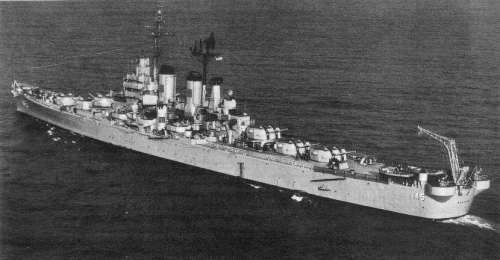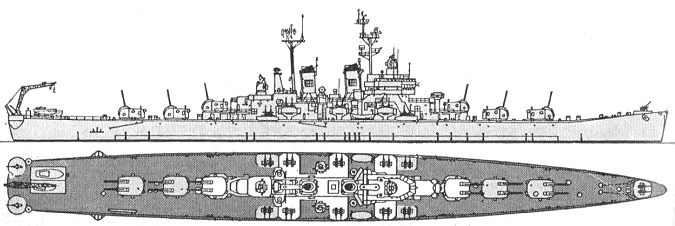
NAVYPEDIA
 Support the project with paypal
Support the project with paypal
Photo

Roanoke 1970
Ships
| No | Name | Yard No | Builder | Laid down | Launched | Comm | Fate |
|---|---|---|---|---|---|---|---|
| CL144 | Worcester | 465 | New York SB, Camden | 29.1.1945 | 4.2.1947 | 25.6.1948 | stricken 1.12.1970 |
| CL145 | Roanoke | 466 | New York SB, Camden | 15.5.1945 | 16.6.1947 | 4.4.1949 | stricken 1.12.1970 |
| CL146 | Vallejo | 467 | New York SB, Camden | 16.7.1945 | --- | --- | cancelled 12.8.1945 |
| CL147 | Gary | 468 | New York SB, Camden | --- | --- | --- | cancelled 12.8.1945 |
Technical data
| Displacement standard, t | 14700 |
|---|---|
| Displacement full, t | 17997 |
| Length, m | 202.4 wl 207.1 oa |
| Breadth, m | 21.5 |
| Draught, m | 7.54 full load |
| No of shafts | 4 |
| Machinery | 4 sets General Electric geared steam turbines, 4 Babcock & Wilcox boilers |
| Power, h. p. | 120000 |
| Max speed, kts | 33 |
| Fuel, t | oil 2400 |
| Endurance, nm(kts) | 8000 (15) |
| Armour, mm | belt: 127 - 76, magazines: 127 - 51, deck: 89 + upper deck: 25 - 22, bulkheads: 102, barbettes: 127, turrets: 165 - 51, CT: 127 sides, 57 roof |
| Armament | 6 x 2 - 152/47 RF Mk 16, 11 x 2 - 76/50 Mk 33, 2 x 1 - 76/50 Mk 34, 6 x 2 - 20/70 Mk 24 |
| Electronic equipment | SR-2, SR-6, SG-6, SP-2, 4x Mk 25, 6x Mk 27, 4x Mk 35 radars |
| Complement | 1401 |
Standard scale images

Worcester 1963

Roanoke 1948
Graphics
Project history
These very large 'light cruisers' were designed to mount the twin 152/47mm automatic DP gun originally proposed by the Bureau of Ordnance as early as 1937, and intended for the Cleveland class as originally designed, in 1939. The project was revived in 1941, with General Board Characteristics calling for twelve 152mm DP guns, no 127mm secondary battery, protection limited to a very thick deck and a speed of at least 33kt. Later the Board accepted conventional side protection comparable to that of the Clevelands, and by the time of design had been completed early in 1944, the Chief of the Bureau of Ships saw it as an effective replacement for the now seriously overloaded Clevelands. He observed, too, that not even the new 127/54mm DP weapon would suffice against the guided missiles being introduced by the Germans and, presumably, the Japanese; the big 152mm with a proximity fuse might well be not merely useful, but absolutely necessary. However, the success of the 152/47mm design inspired the Bureau of Ordnance to develop an automatic 203/55mm, which was suitable for heavy cruisers not much larger than the Worcesters; the General Board at one point recommended that all seven new light cruisers contemplated (CL143-149) be re-ordered as large heavy cruisers. Ultimately production delays in the 203mm gun and the need to send at least a few 152mm DP weapons to sea modified this decision, so that four ships were ordered as 152/47mm DP light cruisers: CL144-147, of which only two were ultimately completed. Protection was to ensure immunity against the 152mm shell between 46 and 138 cables (90° target angle); against 454kg SAP bombs dropped from any altitude; and against 305mm 454kg AP bombs dropped from below 2300m. Bomb protection included a separate 'bomb deck' above the principal armoured deck, as in battleships and some heavy cruisers. Original design included 12 quadruple 40mm Boforses and 20 20mm MGs; both ships were, however, armed exclusively with the 76/50mm gun as completed. Originally planned 4 seaplanes with two catapults also were never carried.
Ship protection
Main belt abreast machinery was 4.4m high. It was 127mm thick (76mm at lower edge) on 16mm STS plating. There were narrow 51mm underwater belts abreast fore and No4 magazines. Underwater belt protecting aft magazines was 127mm thick. Magazines were protected by 93mm bulkheads fore and aft, machinery and magazines were separated by 127-51mm bulkheads. Main deck over main belt was 89mm. There was 22-25mm upper deck one level higher. Barbettes were 127mm thick. Turrets had 165mm faces, 76-51mm sides, 76-51mm rears and 102mm crowns.
Modernizations
1955, both: - 6 x 2 - 20/70, SG-6, SP-2 radars; + SPS-8 radar
Naval service
No significant events.
 HOME
HOME FIGHTING SHIPS OF THE WORLD
FIGHTING SHIPS OF THE WORLD UNITED STATES OF AMERICA
UNITED STATES OF AMERICA CRUISERS
CRUISERS WORCESTER light cruisers (1948 - 1949)
WORCESTER light cruisers (1948 - 1949)
